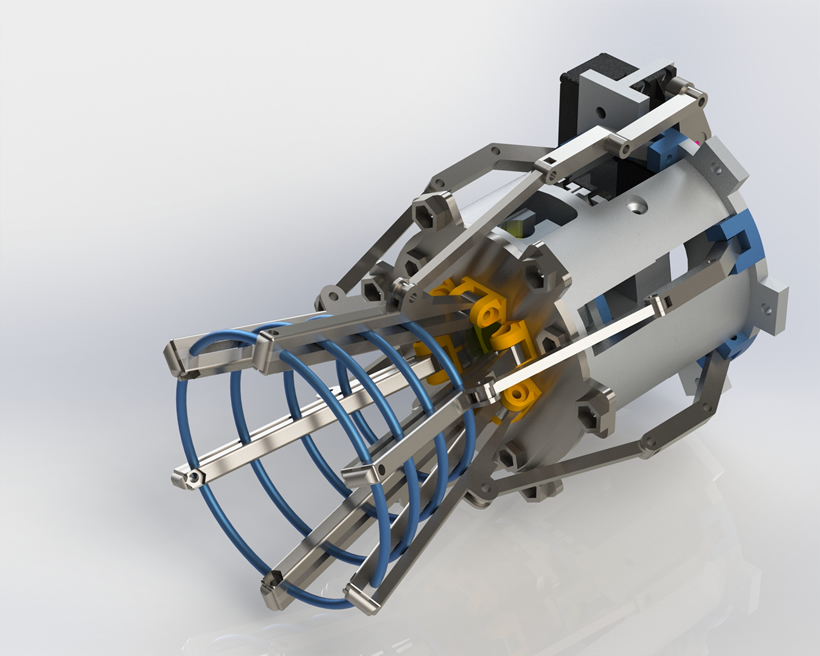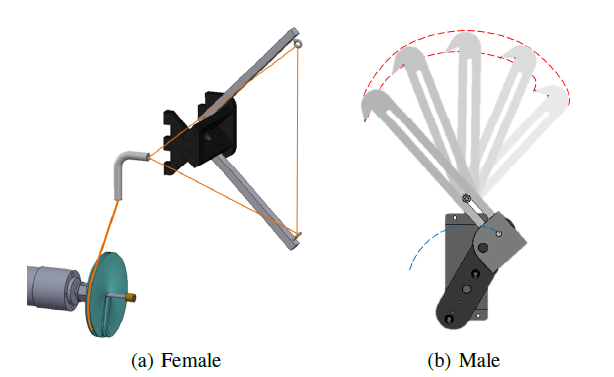The second step of latching is docking, which specifically refers to joining the AUV to a static docking station [17] [15] [16] [14]. Several docking components in AUVs have been widely considered by academy and industry. Among these are:
1) Framed modular garage. The tubular garage is commonly shaped as a cone or funnel, which helps minimizing the level of precision required to dock the AUV by increasing the target size. In this way, the vehicle approaches the funnel entrance, while misalignments are mechanically corrected [15] [16] [14].
2) Stinger. This system is similar to the aircraft base stations, where the airplanes land with the help of a wired hook that latches on a predetermined slot [5].
The funnel helps minimizing the level of precision required to dock the autonomous vehicle by increasing the target size. In this way, the vehicle approaches the funnel entrance, while misalignments are mechanically corrected.

Funnel (female) and pin with bearing stud (male) (left). How it works (right)
The docking stage was tested in different configuration: roboat to roboat; roboat to docking station; roboat to stationary boat. It was tested in indoors and outdoors with extreme waves and still joining the two floating entities.

Roboat docking to a station (left). Roboat docking to a balancing roboat in extreme environment (right)
One specific use case of these robotic boats is to tow and guide floating ”dummy” garbage bins in tight spaces. The challenge to perform the towing of these passive-power-less floating platforms is to design an adaptive latching mechanism, able to create a secure connection between the entities, easy to attach/detach, even if the boats are affected by water disturbances. But most important of all, the adaptive latching must be able to restricting the Degrees Of Freedom (DOF) of the latched ”dummy” platform. Since, the robotic boat may drive it in narrow canals as well as on open water.

Adaptive latching with dynamic funnel and actuated receptor.

Adaptive docking able to tow a power-less "dummy" boat with no thruster, no sensors, only with a tag and a pin for latching.
A simple and waterproof latching mechanism able to grab a rod can enable the roboat to dock to the canal walls. This mechanism integrates only two components: a waterproof limit-switch as sensor and a waterproof servo as actuator to open/close the robotic gripper. The two components can be customized to the Amsterdam docking points. The gripper can open bigger to have a higher tolerance when looking for the rod and the gripper can be customized to any rod dimension.

Roboat mimicking docking to an Amsterdam wall-docking-point for normal boats.
Robotic gripper as latching system.
In this connection mechanism one long side of the module is a male side and the opposing long side is a female side. The male side includes a hook sweeping in the horizontal plane that catches a suspended vertical cable on the female side of another module. Spring loaded folding arms (female side) are used to hold out a loop of string for the hook to catch. A motor winches both ends of the string at once on a spiraled winch drum to allow the spring loaded arms to move out at the same time and at a nonlinear speed during the docking process.


Docking mechanisms. (a) Cable fully extended (female).(b) Hook (male).® O'Hara
When docked, the interface between two modules includes padding on the sides of the hull. This padding lets structures made from the floating modules flex which is important to survive rough sea conditions. The winches in the female side of the docking mechanism can pull two modules tighter, squeezing the padding to provide a controlled stiffness between modules.
We integrated a 2DOF arm - crane on the roboats to help with the docking of two floating robots. The female part is passive in V shape to be pulled by the crane (male). The arms can move up/down and extend/compress to fit in the V shape and pull it creating a new floating structure.
Docking system based on crane - arms.
